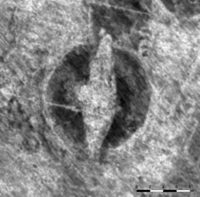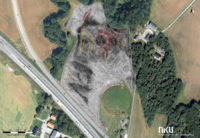 In October 2018, a geophysical survey of a field in Halden, southeastern Norway, revealed the presence of Viking ship burial. The landowner had applied for a soil drainage permit and because the field is adjacent to the monumental Jell Mound, archaeologists from the Norwegian Institute for Cultural Heritage Research (NIKU) inspected the site first. Using a four-wheeler with a georadar mounted to the front of it. The high-resolution ground-penetrating radar picked up the clear outline of a ship 20 meters (65 feet) long.
In October 2018, a geophysical survey of a field in Halden, southeastern Norway, revealed the presence of Viking ship burial. The landowner had applied for a soil drainage permit and because the field is adjacent to the monumental Jell Mound, archaeologists from the Norwegian Institute for Cultural Heritage Research (NIKU) inspected the site first. Using a four-wheeler with a georadar mounted to the front of it. The high-resolution ground-penetrating radar picked up the clear outline of a ship 20 meters (65 feet) long.
The ship was found just 50 cm (1.6 feet) under the surface. It was once covered by a burial mound like its neighbor, but centuries of agricultural work ploughed it away. Subsequent investigation of the area found the outlines of at least 11 other burial mounds around the ship, all of them long-since ploughed out as well. The georadar also discovered the remains of five longhouses.
 In order to get some idea of the ship’s age, condition and how much of it is left, in September of 2019, NIKU archaeologists dug a test pit was dug to obtain a sample of the wood of the keel. The keel was of a different type to ones from other Viking ship burials known in Norway. It is thinner and smaller than usual. The two-week investigation and analysis of the sample found that the ship does indeed date to the early Viking era. The wood was felled between the late 8th century and the start of the 10th century.
In order to get some idea of the ship’s age, condition and how much of it is left, in September of 2019, NIKU archaeologists dug a test pit was dug to obtain a sample of the wood of the keel. The keel was of a different type to ones from other Viking ship burials known in Norway. It is thinner and smaller than usual. The two-week investigation and analysis of the sample found that the ship does indeed date to the early Viking era. The wood was felled between the late 8th century and the start of the 10th century.
In more distressing news, the analysis of the sample revealed that the wooden remains were under severe attack from fungus. The use of fertilizer on the farmland above the ship encourages the fungal growth and not only is the keel plagued by soft rot, the remains even at the deepest point where preservation conditions are the best possible are under acute distress.
Norway’s government has responded to the archaeological emergency by allocating 15.6m kroner (about $1.5 million) to excavate the Gjellestad Viking Ship and get it out of the ground before it rots to nothingness. While other Viking ship burials have been excavated in recent years, the last Viking ship burial mound to be excavated was the Oseberg ship in 1904-1905. If the Norwegian parliament approves the budget, excavation of the Gjellestad Ship is slated to begin in June.
[Jan Bill, curator of the Viking Ship Collection at the Museum of Cultural History,] said that even if the vessel was less well preserved that the team hoped, it could still provide important new information on Viking ship burials, as the Tune, Gokstad, and Oseberg ships, which were excavated in 1868, 1880 and 1904, respectively, were not carried out to modern standards.
“It’s important because it’s more than 100 years ago that we excavated a ship burial like this,” he said. “With the technology we have now and the equipment we have today, this gives us a tremendous opportunity to understand why these ship burials took place.”
“These were very early excavations so there’s a lot of information that we really don’t have because of the way it was done at the time.”
He said that as well as the keel of the boat, there were also signs of burial goods and other matter inside the ship.
“We know that when we excavate we will be able to investigate some of those objects,” he said.
Åwesome! — I was wondering about the ‘aircraft carrier’ that might be hidden under the 80+ meter tumulus with the red circle.
Then I looked it up on OSM, and apparently that’s indeed the mentioned “Jellhaugen“, considered the 2nd biggest tumulus in Norway from ~ 500 AD.
———
no.wikipedia.org/wiki/Jellhaugen (not Viking, and apparently no ship at all)
no.wikipedia.org/wiki/Gjellestadskipet
I think enough Viking burial ships have been excavated. Now, with this new satellite technology, ships are being found with some regularity. I understand that some archaeologists maintain that the ships must be properly excavated so they are no destroyed (by climate change, I think) but meanwhile, the elegant Oseberg ship is slowly deteriorating (presumably from all the exposure to human’s CO2). Personally, I think we should let the dead lie in peace.
Thanks very much for the efforts my pray all goes on successful. The next generation will have a lot to digest
The difference here is the mound & ship together, a type of site never excavated with modern methods.
Also, with the fungus, this ship may soon be gone if left alone.
For me, this is very exciting news. I am truly looking forward to seeing the process unfold In June. I saw the video for this initially 3 hours after it had been released. I too much like many of the Norse blogs I follow, will be writing posts and keeping updated on it on Old Norse Paganism as it unfolds. It’s important to ask questions and get the opinions of numerous blogs and sites to gain wisdom and knowledge of our heritage and religion just as Odin did.
A great example of geophysics!